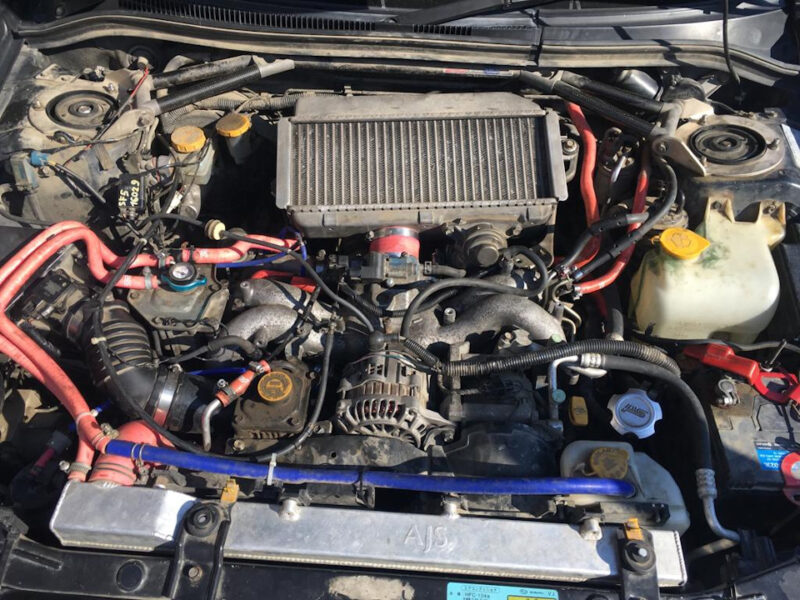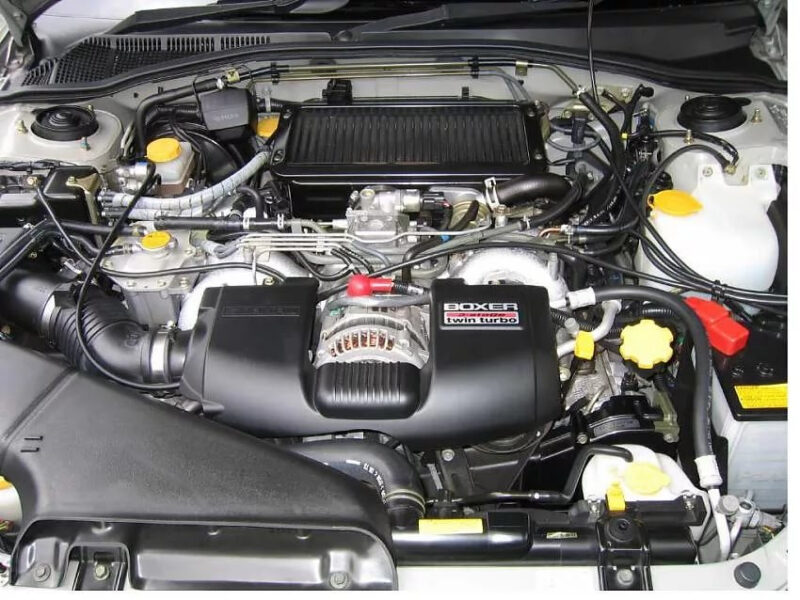2.0-liter turbo engine Subaru EJ208 was assembled in Japanese factories from 1998 to 2003 and was installed only on various sport modifications of the Legacy model for the local market. This powertrain was offered in one single version with 280 hp and 343 Nm.
The EJ20T range also includes EJ20G, EJ205, EJ206 and EJ207.
Subaru EJ208 2.0 Twin Turbo Engine Specifications
| Characteristics | Measurement |
|---|---|
| Fine volume | 1994 cm³ |
| Power System | Injector |
| Drive power | 280 hp |
| Torque | 343 Nm |
| Cylinder block | Aluminum H4 |
| Cylinder head | Aluminum 16v |
| Cylinder diameter | 92 mm |
| Piston stroke | 75 mm |
| Compression ratio | 8.5 – 9.0 |
| Drive features | DOHC |
| Hydrocompensators | No |
| Transmission timing | Belt drive |
| Fasoregulator | No |
| Turbo | Twin-Turbo |
| What oil to use | 4.7 liters 5W-30 |
| Environmental class | Euro 2/3 |
| Example service life | 210,000 km |
| EJ208 engine weight | 160 kg |
Subaru EJ208: problems, weaknesses and recall campaigns

The EJ208 is an advanced version of Subaru’s famous turbocharged opposition engine, installed in the JDM versions of the Legacy B4 (BE/BH) and Lancaster GT. It is essentially an evolution of the EJ206, but with a number of improvements: AVCS phase shifters, a modernized bi-turbocharging system and softer steering. Nevertheless, like all representatives of the EJ series, especially with a biturbo system, it has its own collection of characteristic problems.
Main problems and shortcomings of the EJ208
Liner rotation due to drop in oil pressure
Like most turbo EJs, the EJ208 is critical of oil pressure. This is especially true as the motor ages – pumps lose performance and a dirty oil pan restricts flow. The result is liner rotation, which often ends with engine jamming and overhaul.
Oil and lube leaks
The EJ208 leaks oil in two directions:
- Through the piston group and turbos – especially at high loads.
- Through oil seals, valve cover gaskets, front and rear covers – a result of aging rubber and overheating.
The oil level should be checked frequently, otherwise you risk oil starvation.
Transmission timing belt and bent valves
The EJ208 has a timing belt, and like most opposition engines, it is guaranteed to bend valves if it breaks. The recommended replacement interval is every 100,000 km, but if you drive the car hard, sooner is better. Replacement requires experience due to the dense layout.
Problematic cooling system
The complex cooling system configuration and bi-turbo dodger are often the cause of regular overheating. Typical causes:
- Air plugs.
- A weak pump.
- Clogged radiator.
- Thermostat failure.
Overheating leads to deformation of the cylinder head and even the block itself, especially in aluminum units with high mileage.
Cylinder knocking and deformation
If the motor has often overheated, over time a characteristic knock appears – most often in the 4th cylinder. This can indicate:

- Warping of the block.
- Enlarged clearances.
- Scoring and violation of geometry of the CKC.
EJ208 recall campaigns
Unlike the EJ205 or EJ255, the EJ208 engine was supplied exclusively to the Japanese market (JDM), so there were no global recall campaigns. However, there were localized service bulletins (TSBs) in Japan:
Oil System Service Notices
Subaru in Japan published a TSB on checking the oil pressure regularly and replacing the oil pump with updated versions if the pressure drops. There was also a recommendation to clean the oil pickup at mileage over 100,000 km.
Biturbo system maintenance
On the EJ208, the second turbo was often observed to malfunction – delayed engagement, staggered response. This was due to clogged vacuum lines and supercharger shift valves. Service bulletins contained instructions for diagnosing and replacing control solenoids and actuators.
AVCS problems
Some batches of motors had sticky or slow timing solenoids, causing erratic transient operation. Subaru recommended replacing or cleaning the solenoids as part of the routine maintenance.
Conclusion
EJ208 is an interesting and quite technological motor with excellent potential, especially for tuning and JDM-projects. But it requires:
- Continuous monitoring of oil pressure,
- attention to the cooling system.
- regular timing changes.
- and patience with the complex biturbo system.
This is not a motor “for everyone” – its reliability depends largely on the quality of service and timely preventive maintenance. One omission and you risk hearing the knocking and squealing of the liners.
